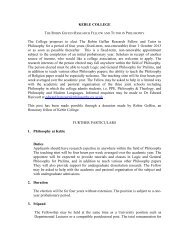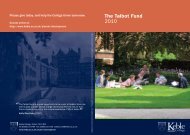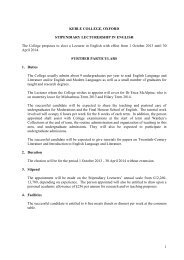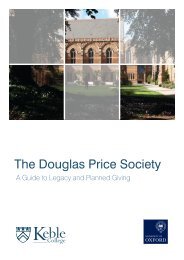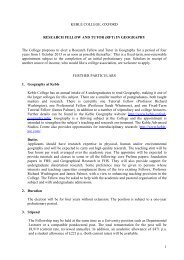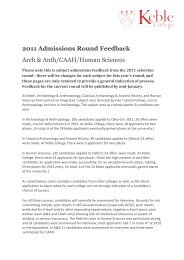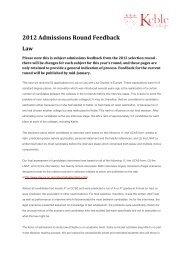The Record 2006 - Keble College - University of Oxford
The Record 2006 - Keble College - University of Oxford
The Record 2006 - Keble College - University of Oxford
Create successful ePaper yourself
Turn your PDF publications into a flip-book with our unique Google optimized e-Paper software.
<strong>The</strong> Life <strong>of</strong> the <strong>College</strong><br />
to say that the risks <strong>of</strong> contracting radiation-induced cancer are not<br />
known. [<strong>The</strong>re always remains a statistical error, in this case at the<br />
level <strong>of</strong> parts per thousand.]<br />
In every situation there are special risks which require special<br />
safety measures. In the case <strong>of</strong> nuclear accidents such a risk is the<br />
inhalation <strong>of</strong> radioactive iodine which is rapidly absorbed by the<br />
thyroid, especially in young children. This then causes cancer over<br />
the following decades. <strong>The</strong> special measure requires the population<br />
to take iodine tablets during the three weeks following an accidental<br />
release. This dilutes the radioactive iodine to the point where its uptake<br />
by the thyroid is negligible. This has been known for decades but was<br />
ignored in the aftermath <strong>of</strong> Chernobyl. So far some 1100 children have<br />
contracted cancer, <strong>of</strong> whom 3 have died (1998). <strong>The</strong> incidence peaked<br />
in 1995 and is falling <strong>of</strong>f. This was an entirely avoidable addition to the<br />
accident.<br />
A fresh estimate <strong>of</strong> safe levels <strong>of</strong> ionising radiation in an era <strong>of</strong> global<br />
warming<br />
<strong>The</strong> costs <strong>of</strong> nuclear power are predicated on safety levels. <strong>The</strong><br />
numbers above suggest that regulation levels for nuclear safety should<br />
be relaxed by a factor 300 from 1mSv/yr to 25mSv/month for the<br />
general public. Such a safety limit would still have a very conservative<br />
ratio relative to a lethal dose (6000 mSv/25mSv = 240), compared for<br />
example with tissue heating by ultrasound, (50ºC/1ºC = 50). Relative<br />
to marginal damage levels the ratios would be 100mSv/25mSv = 4<br />
and 2ºC/1ºC = 2, respectively. This change would significantly reduce<br />
the supposed costs <strong>of</strong> nuclear power including decommissioning. A<br />
combination <strong>of</strong> nuclear and renewable power in the next 50 years<br />
would give time for the development <strong>of</strong> clean thermonuclear fusion<br />
power whose feasibility can no longer be doubted.<br />
This discussion has skipped many details and is debatable at the<br />
level <strong>of</strong> factors <strong>of</strong> two. However the factors <strong>of</strong> ten are defensible, and<br />
an adjustment by a factor 300 <strong>of</strong> nuclear safety levels should have<br />
significant and immediate consequences for energy policy.<br />
This article is based on a lecture given in <strong>College</strong> at the Reunion<br />
weekend for 1957–62s in April this year and is the subject <strong>of</strong><br />
a book Fundamental Physics for Probing and Imaging<br />
published in October. Available through bookshops, or direct from<br />
OUP at:<br />
http://www.oup.com/uk/catalogue/?ci=9780199203888<br />
http://www.oup.co.uk/isbn/0-19-920389-X<br />
19




